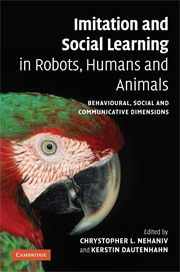 Imitation and Social Learning in Robots, Humans and Animals
Imitation and Social Learning in Robots, Humans and Animals Published online by Cambridge University Press: 10 December 2009
Introduction
The functional role of early imitation has been discussed in a variety of contexts. Its role for the cognitive development of the child has been regularly emphasized since Piaget (1962). Its communicative function and its role for the development of social coordination know-how have also been put forward (Nadel, 2002). Early imitative capabilities could also be important in the process of identification with others helping the very young infant to take a ‘like-me stance’ (Meltzoff and Gopnick, 1993). Eventually, it has been argued that infants also engage in ‘self-imitation’ and that this process is crucial for the objectivation of themselves as distinct entities (Rochat, 2002). This multiplicity of approaches points to a consensus that early imitation is a crucial basic mechanism for the development of cognitive, social and communicative aspects of children's behaviour and even more generally for the construction of their awareness about themselves, others and the external environment. Despite its importance, a question regarding early imitation remains only partially answered: what pushes animals and infants to engage in imitative behaviour?
Early imitation seems to appear at an age when children do not discriminate clearly between themselves and others. It is argued that early imitation actually plays a role for identification with and discrimination from others. As a consequence, potential mechanisms for early imitation should not rely on the notions of self and others.
To save this book to your Kindle, first ensure no-reply@cambridge.org is added to your Approved Personal Document E-mail List under your Personal Document Settings on the Manage Your Content and Devices page of your Amazon account. Then enter the ‘name’ part of your Kindle email address below. Find out more about saving to your Kindle.
Note you can select to save to either the @free.kindle.com or @kindle.com variations. ‘@free.kindle.com’ emails are free but can only be saved to your device when it is connected to wi-fi. ‘@kindle.com’ emails can be delivered even when you are not connected to wi-fi, but note that service fees apply.
Find out more about the Kindle Personal Document Service.
To save content items to your account, please confirm that you agree to abide by our usage policies. If this is the first time you use this feature, you will be asked to authorise Cambridge Core to connect with your account. Find out more about saving content to Dropbox.
To save content items to your account, please confirm that you agree to abide by our usage policies. If this is the first time you use this feature, you will be asked to authorise Cambridge Core to connect with your account. Find out more about saving content to Google Drive.